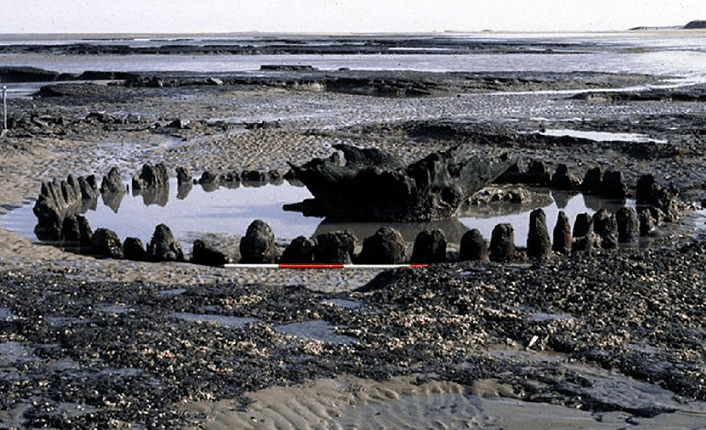
Seahenge: A Subaquatic Monument of The European Bronze Age
In 1998, when an amateur archaeologist was out catching shrimp off the coast of England, he couldn’t believe what he stumbled upon. “Stonehenge’s underwater sister”, now known as Seahenge. Since the discovery of this fascinating 4000-year-old Bronze Age monument, it has been surrounded by mystery, unanswered questions and controversy.
By Aleksa Vučković | Ancient Origins
Today, the United Kingdom is crisscrossed with many fascinating monuments from ancient times. From the ages when these islands were inhabited by different peoples and cultures of tribes from ancient Europe, who shared many intriguing beliefs and lived in a great symbiosis with the nature around them. From passage tombs and burial mounds, to megaliths, the iconic Stonehenge and now ‘Seahenge’, these remnants from a time long gone are still an important connection with the lives of all our ancestors. They are the fibre that bonds the past and the present – a real passageway that leads us back through time.
But one such discovery defied all odds and survived the tireless beating of passing time, for several thousand years. This discovery is so exceptional because of the fact that it is not made of stone – but of wood! Today we are bringing you the story of one of UK’s most mysterious ancient monuments – the so-called Seahenge. Join us as we pierce the veil of time to discover the true purpose of this fascinating wood ring.
The Origins of Seahenge and its Discovery
The small, picturesque village of Holme-next-the-Sea is situated in the English county of Norfolk, nestled right on the coast. On a first glance it is just like all Norfolk hamlets – cozy and snug, captivating with its rural and simple charm. It is a seaside village that perfectly captures the nature and wildlife, which is found in England’s marshes and in the North Sea. But a remarkable discovery in 1998 woke this hamlet up from its lull and sent waves through the English and global archaeological community.
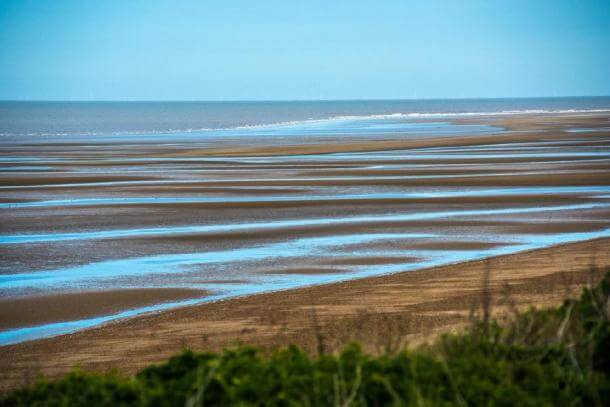
In the early spring of that year, an amateur archaeologist named John Lorimer was casually catching shrimps on the beach near Holme, with his brother-in-law. These North Sea Norfolk beaches have a distinct look, and low tide can give a chance to spot some interesting things. And that is exactly what happened to Mr. Lorimer, because it wasn’t a shrimp he found – but a Bronze Age axe head. It was the second such axe head found on that beach within a time frame of just a few months, and Lorimer recognized the fact that it was not by mere chance that it happened. So he kept returning to the Holme beach in the hope of further discoveries, but what he eventually found was thoroughly unexpected.
Emerging from the wave-washed sand was an upturned tree stump. The first guess was a logical one – an Anglo-Saxon fish trap, which were not unusual around the area. But as the tide receded, more and more, details began emerging from the sand. What was seen was astonishing and quite unique -a circle of timber posts with a huge upturned stump in the very centre. The importance was quickly recognized, and professionals were soon at the scene.
Unique Bronze Age Monument
What was the true purpose of this timber circle? Who erected it? Well, research confirmed that the so-called Seahenge was definitely old. In fact, really, really old. It dated to the Bronze Age, and it was erected roughly around 2049 BC. With accurate research and dating of the wood samples, scientists could pinpoint 2049 BC as the date when the trees were cut down.
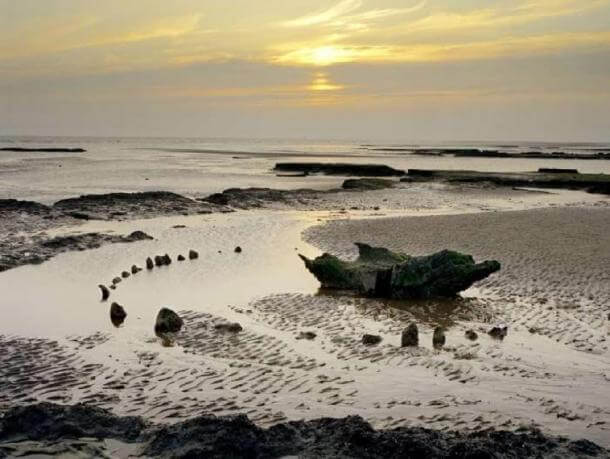
The wooden circle consists of fifty-five split oak trunks, which were carefully arranged into a circle and measured around 7 by 6 meters (23 by 20 feet). The trunks were split in half vertically and arranged so that the round side with the bark was facing outwards and flat side inwards – with only a single trunk being placed the opposite way. The reason for this is unknown, and it was most likely done with a purpose.
It was deduced that only one of these trunks allowed an entrance into the circle, as it had a narrow passage in the form of a Y shaped fork. In front of this opening stood another trunk, which inhibited people from peering into the circular enclosure. Since the timbers survived a great length of time, they had eroded greatly, and it is not known how tall they originally were. Inside the circle was the iconic stump – turned upside down, with its branching roots pointing upwards.
Ancient Beliefs: What Was the Purpose of Seahenge?
But what about the purpose of this wooden enclosure? Since its discovery, Seahenge baffled scientists and gave rise to many theories, all of them quite possible. One thing is certain – its ritual purpose. Several scholars agree that Seahenge was directly related to the burial practices in Bronze Age Britain.
It is purported that the enclosure was used for excarnation. This was an ancient funerary practice where flesh was removed from the bodies – similar to the modern Tibetan Sky Burial tradition. Seemingly the deceased were placed on top of the upturned stump, where they were left exposed to the weather and the birds of prey. Ancient natives of Britain might have believed in the spirit continuing to live beyond the disappearance of flesh, and a return to the nature. All around them was possible with the mortal remains consumed by the birds of prey and scattered.
Scholars believe that excarnation was most often practiced for women and children, as there is a great disparage of archaeologically excavated Bronze Age skeletons, where male remains are much more common than those of females and children.
Another possible role of Seahenge was ceremonial. There is great symbolism in the layout of this wooden circle. Some think that it symbolized a boundary between life and death, between the mortal world and the one beyond. As it is placed close to the sea, it is believed that Bronze Age people thought the sea was the world’s edge, with the realm of the dead lying beyond their shores and far in the distant horizons.
Still, we cannot know the answer for sure, as time has certainly washed away the original purpose of Seahenge. However, it is easy to deduce that it had immense importance for the people of this region, and its symbolism is proof of this.
Seahenge gave scholars and scientists some crucial insights into the life of Bronze Age people that inhabited Britain. Thanks to the degree of preservation of the trunks, a lot has been learned through testing. The trunks still display visible marks of hewing and narrowing down to a point. Research showed that this was done with between 30 and 40 bronze axes, all of which came from the region of Cornwall. It is clear that the ancient inhabitants of modern Norfolk most certainly engaged in trade with their neighbouring tribes, and they had to travel quite a distance to acquire their bronze tools.

A less credible and less logical theory is that the workforce was in fact from Cornwall. Other research helped scientists to pinpoint the exact period of the construction, when the trees were felled, to the late spring or early summer of 2049 BC, all on the same day. This tells us that it was an important, planned event that had to involve a lot of people, perhaps as much as 50. This is another important insight into society of the past. It suggests that strong communities did exist around this time and large-scale constructions were very familiar to them.
When it comes to the surroundings of Seahenge, details were much scarcer. In 2049 BC, the area looked slightly different, and the henge was situated on a salt marsh, also known as a tidal marsh. As time progressed, it became a freshwater wetland, and this ecosystem allowed the growth of trees. As these decayed over the centuries, they became a layer of peat that covered the flats. As the time rolled onward, so did the sea, and the peat layers were covered by sand and saltwater, which preserved the remains. We can thus deduce that originally it was built deeper inland, but that the area became the current beach over the millennia.
Although little excavations could be made in the vicinity of Seahenge, they yielded some interesting finds. Archaeologists could not find any material from the earliest periods of the henge’s use, but finds of Mid to Late Bronze Age pottery sherds, tell us that the site saw a period of prominent use, several centuries after it was constructed.
Destruction or Preservation? – A Conflict Emerges
When Seahenge was officially discovered in 1998, although it was a majestic find, it was still a little controversial, which led to a conflict between several involved parties shortly after the initial find. Seahenge itself was only named after 1998 and had no name before that, although it was already somewhat known to the locals, who knew of its existence for some time. And when scientists and archaeologists began their proper excavations, several voices rose in opposition.
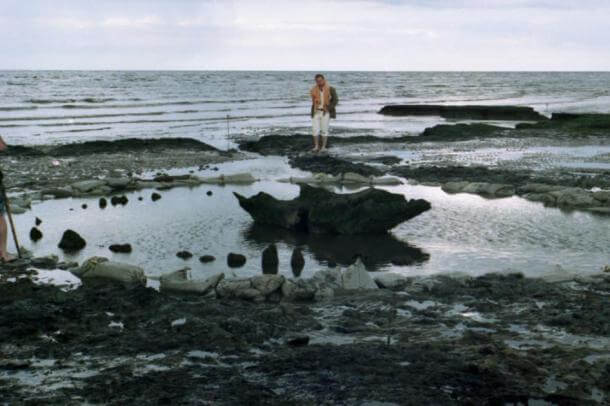
First there were the locals. They desired to retain the remnants of the wooden circle and display it locally – in hopes of attracting tourists to their region and having a piece of heritage for their village. Then there were the modern ‘ Druids’ and ‘Neopagans’. They gave adamant opposition to the disturbance of the remains and wanted them to remain in situ and untouched, to avoid sacrilege.
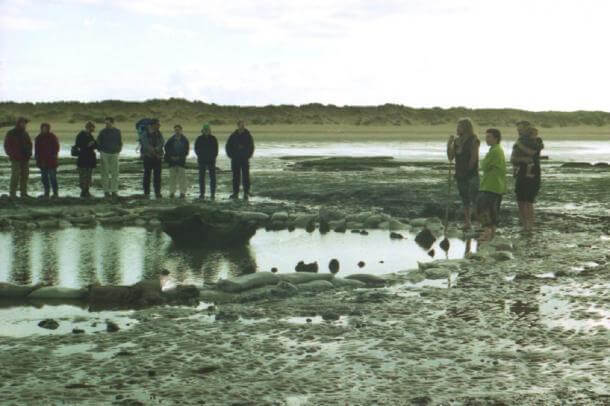
In time, they launched a proper publicity campaign against the scientists, who wanted to remove the remnants and take them for preservation and display in a museum. Eventually, the research team managed to acquire a high court injunction, which prevented several of the key protesters to approach the site.
The media soon picked up on the discovery and the conflict, and the news soon spread. The wooden circle was soon dubbed the “ Stonehenge of the Sea”, “Stonehenge Beneath the Sea”, and “Stonehenge’s Underwater Sister.” As a result, it eventually received its name of Seahenge, even though it is most likely not a henge.

Wildlife protection also entered the fray with their own complaints, claiming that the increasing visitors to the site – some 5000 of them in the first year after discovery – disturbed the wildlife of the area, in particular the wader birds.
The area was a part of Holme Dunes National Nature Reserve. The publicity reached its all-time high in 1999, when the famous Channel 4 historical show called Time Team ran a special documentary episode on Seahenge and the legal battle over its excavation
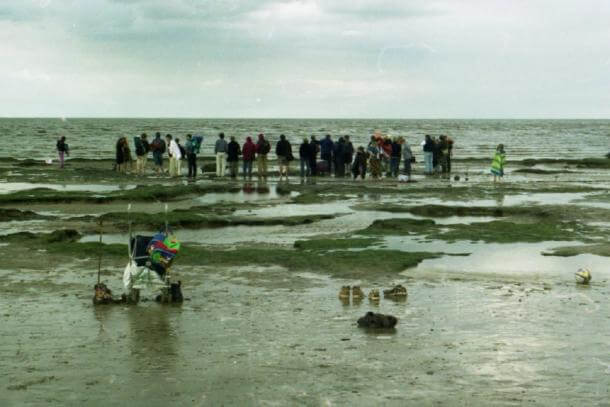
In the end, the English Heritage team of excavators had the last word and completely removed Seahenge from its original position – albeit under the watchful gaze of the many gathered protesters, the media, and the police force. At the climax point of the excavation, when the majestic tree stump was being pulled out, a distressed young female protester dashed through the protective circle and the police force, in an attempt to stop the excavation. In the end, she was subdued and removed from the site.
What Happened to Seahenge?
The remains of Seahenge were transported to a field centre of the Fenland Archaeology Trust at Flag Fen, in Cambridgeshire. There, they were preserved by immersion in fresh water, and underwent thorough cleaning, scanning, processing, and further conservation.
A very interesting and unique method of preserving them was employed and in particular, the remains were continually soaked over the years, in wax-emulsified water. This resulted in the moisture, that was gathered in the wood over the centuries, to be replaced with wax. In the end, the entire remnants of Seahenge were successfully preserved for posterity and stored. A replica was put on display in King’s Lynn Museum in King’s Lynn, in 2008.
A Link to Connect the Ages
Seahenge is not the only discovery of its type in England. Just a hundred meters to the east of Seahenge, another double wood circle was discovered, albeit smaller and less preserved. But it is a clear indication that these wood enclosures were a very important ritual tradition for Bronze Age Britain natives, especially in East Anglia.
Sites like these are a true treasure of archaeology, and some of the most important links to the Bronze Age cultures of Europe. They show us the image of a past long gone, of lives that were deeply in tune with the world around them, and who believed in things deeper and more mysterious than we perhaps dare to realize. And time no longer threatens their survival – they are immortal.
This article (Seahenge: A Subaquatic Monument of The European Bronze Age) was originally published on Ancient Origins and is published under a Creative Commons license.
